Thermal Spray Coatings of Al, ZnAl and Inconel 625 Alloys on SS304L for Anti-Saline Corrosion
Abstract
:1. Introduction
2. Experimental Procedure
2.1. Thermal Spray Process
2.2. Coating Surface Characterization: Porosity, Bonding Strength, and Hardness
2.3. Corrosion Test
2.4. Scanning Electron Microscopy and Energy Dispersive Spectroscopy (SEM/EDS)
2.5. X-Ray Diffractometer
2.6. Electrochemical Analyses
3. Results and Discussion
3.1. Mechanical Properties and Surface Morphology of Thermal Spray Coatings
3.2. Crystalline Structures of the Thermal Spray Coatings
3.3. Surface Analysis of the Corrosion Specimens
3.4. Cross-Sectional Analysis of the Corrosion Specimens
3.5. Electrochemical Analysis of the Corrosion Specimens
4. Conclusions
Author Contributions
Funding
Conflicts of Interest
References
- Kurc–Lisiecka, A.; Kalinowska–Ozgowicz, E. Structure and mechanical properties of austenitic steel after cold rolling. J. Achiev. Mater. Manuf. Eng. 2011, 44, 148–153. [Google Scholar]
- Sharifitabar, M.; Halvaee, A.; Khorshahian, S. Microstructure and mechanical properties of resistance upset butt welded 304 austenitic stainless steel joints. Mater. Des. 2011, 32, 3854–3864. [Google Scholar] [CrossRef]
- Wang, K.; Che, H.; Lei, M. Corrosion-fatigue properties of plasma-based low-energy nitrogen ion implanted AISI 304L austenitic stainless steel in borate buffer solution. Surf. Coat. Technol. 2016, 288, 30–35. [Google Scholar] [CrossRef]
- Drożdż, M.; Kyzio, K.; Grzesik, Z. Chromium-based oxidation-resistant coatings for the protection of engine valves in automotive vehicles. Mater. Technol. 2017, 51, 603–607. [Google Scholar] [CrossRef]
- Song, R.; Xiang, J.; Hou, D. Characteristic of mechanical properties and microstructure for 316L austenitic stainless steel. J. Iron Steel Res. Int. 2011, 18, 53–59. [Google Scholar] [CrossRef]
- Jafarzadegan, M.; Abdollah-Zadeh, A.; Feng, A.H.; Saeid, T.; Shen, J.; Assadi, H. Microstructure and mechanical properties of a dissimiliar friction stir weld between austenitic stainless steel and low carbon steel. J. Mater. Sci. Technol. 2013, 29, 367–372. [Google Scholar] [CrossRef]
- Ewing, R.C. Long-term storage of spent nuclear fuel. Nat. Mater. 2015, 14, 252–257. [Google Scholar] [CrossRef]
- Katayama, H.; Kuroda, S. Long-term atmospheric corrosion properties of thermally sprayed Zn, Al and Zn–Al coatings exposed in a coastal area. Corros. Sci. 2013, 76, 35–41. [Google Scholar] [CrossRef]
- Botsch, W.; Smalian, S.; Hinterding, P.; Völzke, H.; Wolff, D.; Kasparek, E.-M. Safety aspects of dry spent fuel storage and spent fuel management. In Proceedings of the ASEM 2013 15th International Conference on Environmental Remediation and Radioactive Waste Management, Brussels, Belgium, 8–12 September 2013. [Google Scholar]
- Einziger, R.E.; Tsai, H.C.; Billone, M.C.; Hilton, B.A. Examination of spent fuel rods after 15 years in dry storage. In Proceedings of the 10th International Conference on Nuclear Engineering, Arlington, VA, USA, 14–18 April 2002. [Google Scholar]
- NRC Information Notice 2012-20: Potential Chloride-Induced Stress Corrosion Cracking of Austenitic Stainless Steel and Maintenance of Dry Cask Storage System Canisters; NRC: Rockville, MD, USA, 2012.
- Tani, J.-I.; Mayuzumi, M.; Hara, N. Stress corrosion cracking of stainless-steel canister for concrete cask storage of spent fuel. J. Nucl. Mater. 2008, 379, 42–47. [Google Scholar] [CrossRef]
- Xiao, Y.; Jiang, X.; Xiao, Y.; Ma, L. Research on Zn–Al15 thermal spray metal coatings and its organic painting composite system protection performance. Procedia Eng. 2012, 27, 1644–1653. [Google Scholar] [CrossRef]
- Skerry, B.S.; Simpson, C.H. Corrosion and weathering of paints for atmospheric corrosion control. Corrosion 1993, 49, 663–674. [Google Scholar] [CrossRef]
- Zeng, R.; Li, X.; Liu, Z.; Zhang, F.; Li, S.; Cui, H. Corrosion resistance of Zn–Al layered double hydroxide/poly(lactic acid) composite coating on magnesium alloy AZ31. Front. Mater. Sci. 2015, 9, 355–365. [Google Scholar] [CrossRef]
- Marchebois, H.; Savall, C.; Bernard, J.; Touzain, S. Electrochemical behavior of zinc-rich powder coatings in artificial sea water. Electrochem. Acta 2004, 49, 2945–2954. [Google Scholar] [CrossRef]
- Pereira, D.; Scantlebury, J.D.; Ferreira, M.G.S.; Almeida, M.E. The application of electrochemical measurements to the study and behaviour of zinc-rich coatings. Corros. Sci. 1990, 30, 1135–1147. [Google Scholar] [CrossRef]
- Edrisy, A.; Perry, T.; Cheng, Y.T.; Alpas, A.T. Wear of thermal spray deposited low carbon steel coatings on aluminum alloys. Wear 2001, 251, 1023–1033. [Google Scholar] [CrossRef]
- Sokołowski, P.; Pawłowski, L.; Dietrich, D.; Lampke, T.; Jech, D. Advanced microscopic study of suspension plasma-sprayed zirconia coatings with different microstructures. J. Therm. Spray Technol. 2016, 25, 94–104. [Google Scholar] [CrossRef]
- Leonard, A. Review of External Stress Corrosion Cracking of 22%Cr Duplux Stainless Steel Phase 1—Operational Data Acquistion; Health & Safety Executive: Bootle, UK, 2003.
- Gedzevicius, I.; Valiulis, A.V. Influence of the particles velocity on the arc spraying coating adhesion. Mater. Sci. 2003, 9, 334–337. [Google Scholar]
- Steffens, H.-D.; Nassenstein, K. Influence of the spray velocity on arc-sprayed coating structures. J. Therm. Spray Technol. 1999, 8, 454–460. [Google Scholar] [CrossRef]
- Jandin, G.; Liao, H.; Feng, Z.Q.; Coddet, C. Correlations between operating conditions, microstructure and mechanical properties of twin wire arc sprayed steel coatings. Mater. Sci. Eng. A 2003, 349, 298–305. [Google Scholar] [CrossRef] [Green Version]
- Harvey, M.D.F.; Shrestha, S.; Sturgeon, A.J. Coatings for offshore applications by high velocity wire flame spraying. In Proceedings of the NACE 2005, Houston, TX, USA, 3–7 April 2005. [Google Scholar]
- ASTM C633-13(2017) Standard Test Method for Adhesion or Cohesion Strength of Thermal Spray Coatings; ASTM International: West Conshohocken, PA, USA, 2017.
- Carrasquero, E.J.; Lesage, J.; Puchi-Cabrera, E.S.; Staia, M.H. Fretting wear of HVOF Ni–Cr based alloy deposited on SAE 1045 steel. Surf. Coat. Technol. 2008, 202, 4544–4551. [Google Scholar] [CrossRef]
- Chen, T.-C.; Chou, C.-C.; Yung, T.-Y.; Tsai, K.-C.; Huang, J.-Y. Wear behavior of thermally sprayed Zn15Al, Al and Inconel 625 coatings on carbon steel. Surf. Technol. Sci. 2016, 303, 78–85. [Google Scholar]
- Lee, H.-S.; Singh, J.K.; Ismail, M.A.; Bhattacharya, C. Corrosion resistance properties of aluminum coating applied by arc thermal metal spray in SAE J2334 solution with exposure periods. Metals 2016, 6, 55. [Google Scholar] [CrossRef]
- Abioye, T.E.; Mccartney, D.G.; Clare, A.T. Laser cladding of Inconel 625 wire for corrosion protection. J. Mater. Process. Technol. 2015, 217, 232–240. [Google Scholar] [CrossRef] [Green Version]

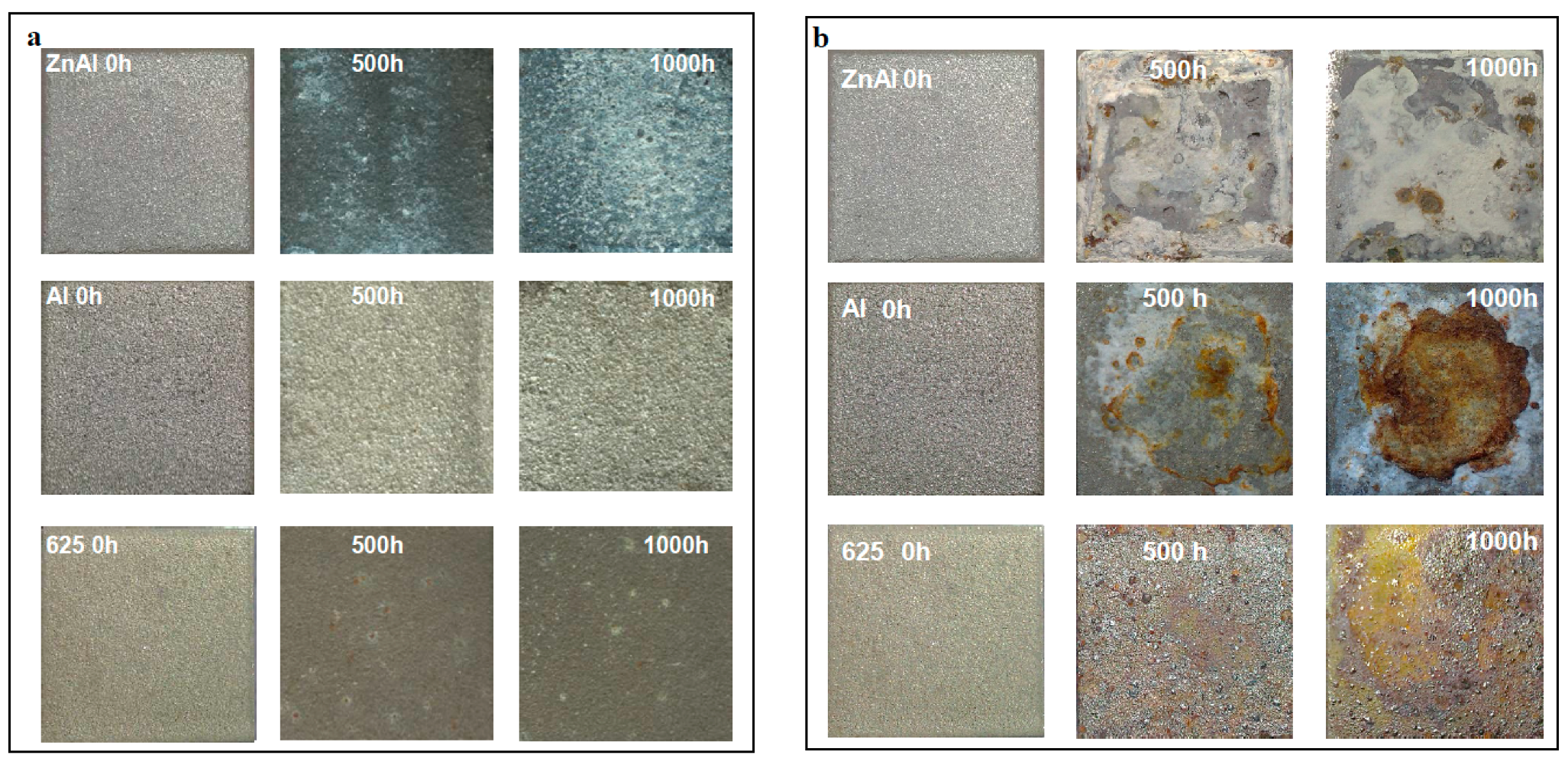

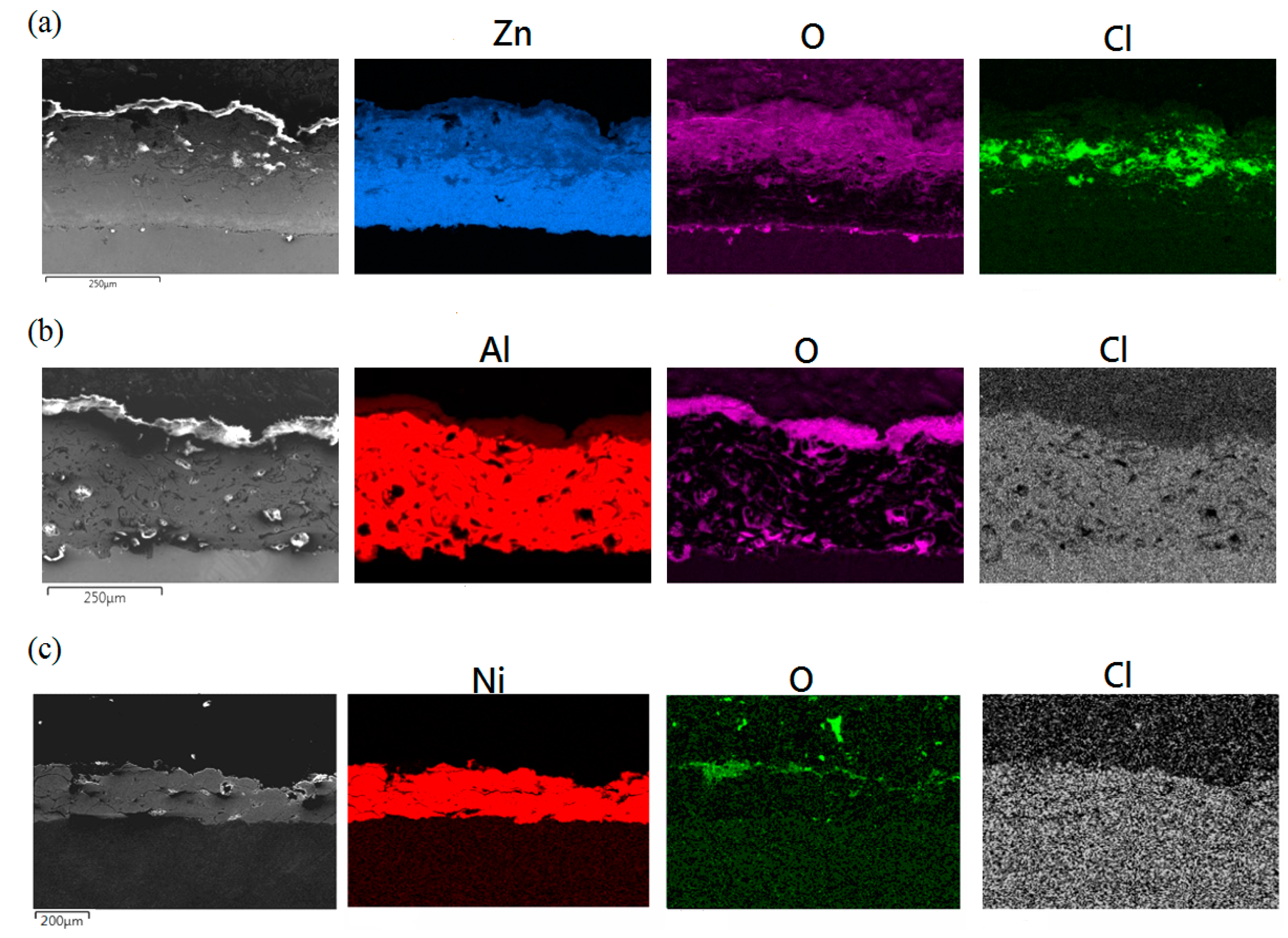
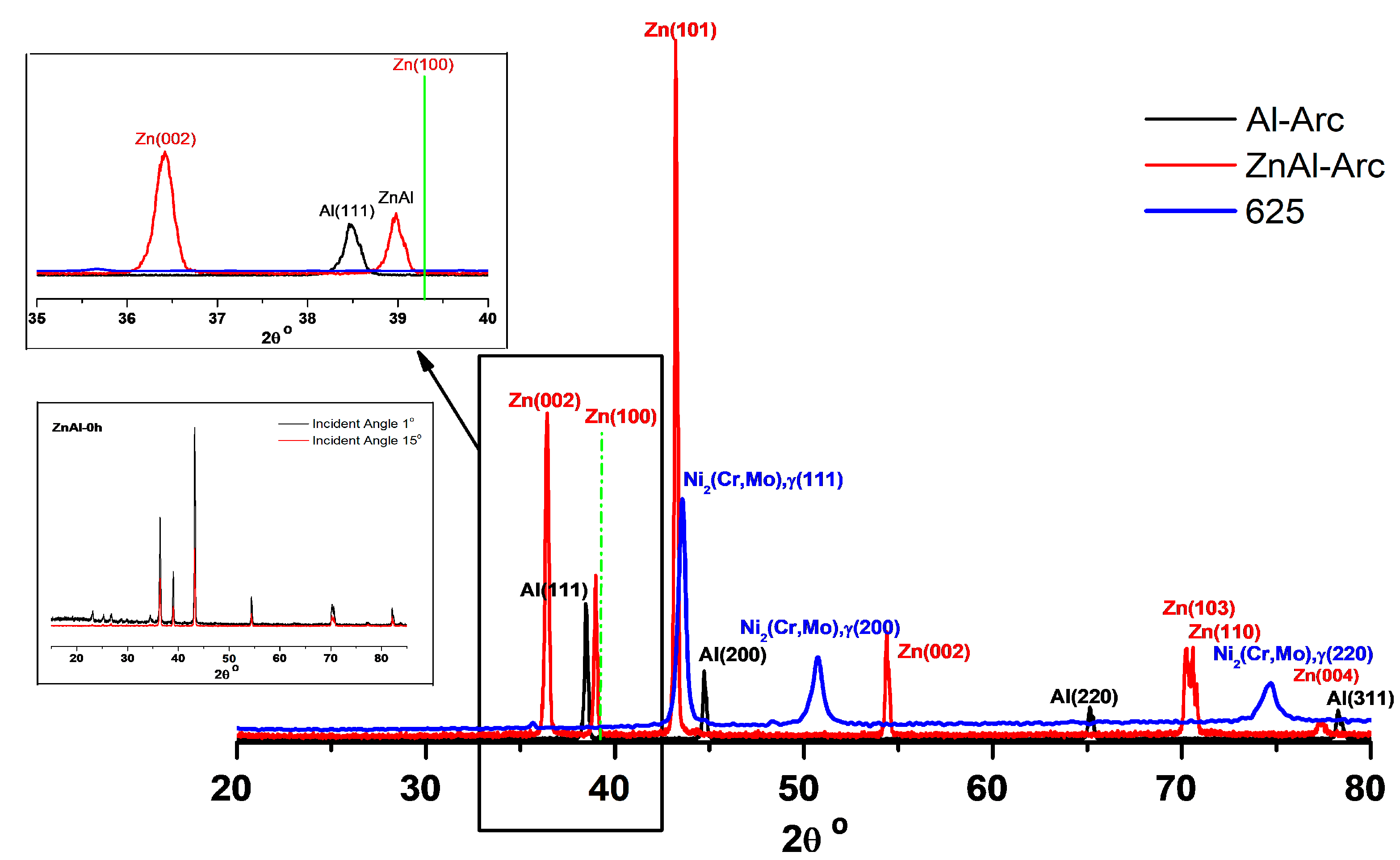
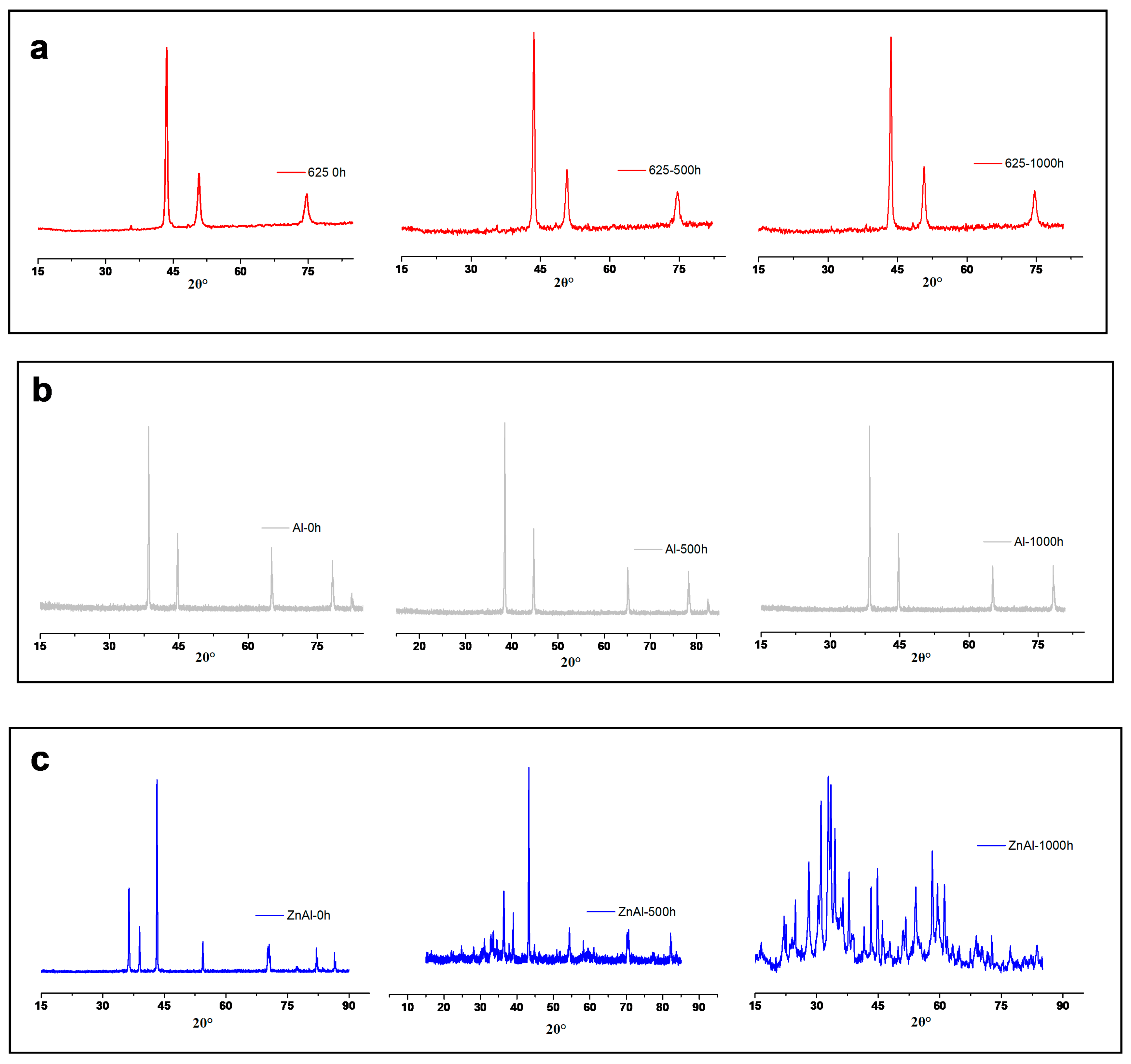
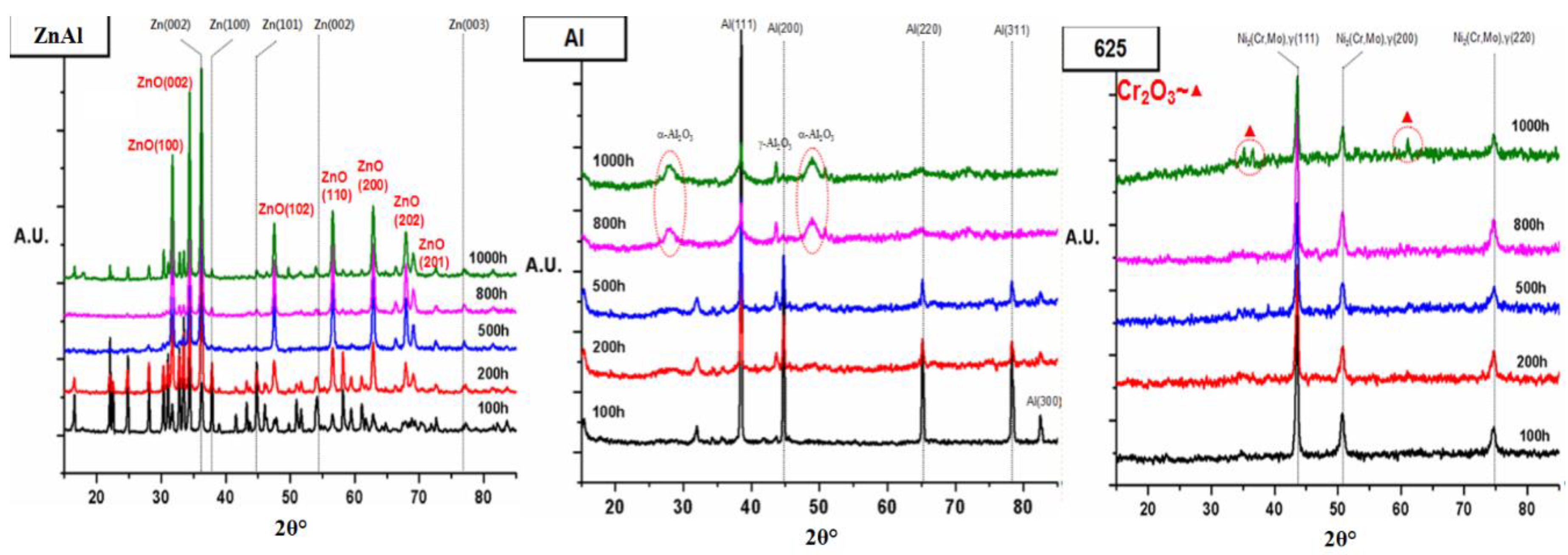
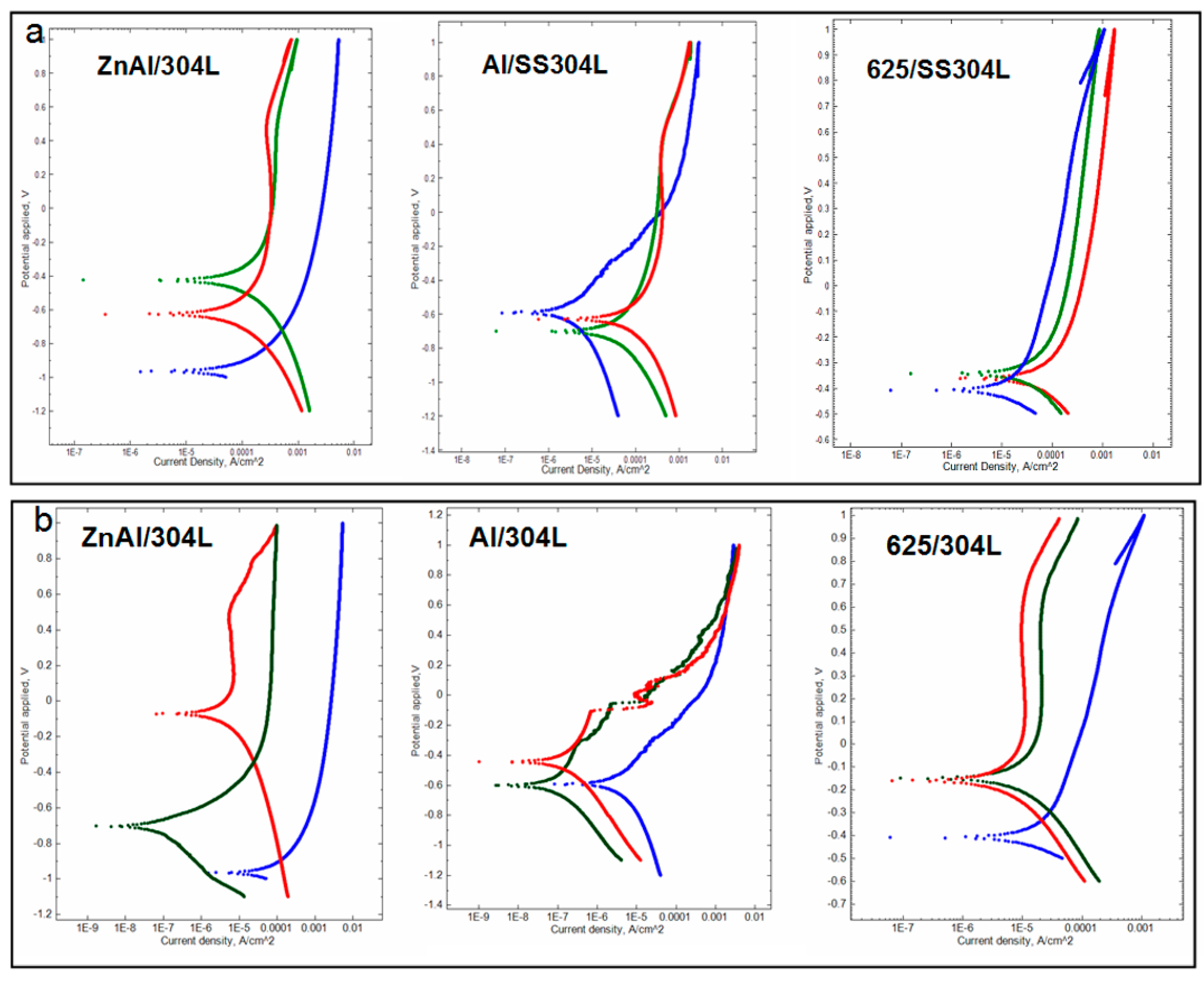
| Coating | C | Si | Mn | Zn | Al | Co | Cr | Ni | Fe | Mo | Nb | P |
|---|---|---|---|---|---|---|---|---|---|---|---|---|
| Inconel 625 | – | – | – | – | – | 0.11 | 21.77 | 62.53 | 3.01 | 8.89 | 3.69 | – |
| Al | – | 0.04 | – | – | 99.79 | – | – | – | 0.17 | – | – | – |
| ZnAl | – | – | – | 85.09 | 14.89 | – | – | – | 0.02 | – | – | – |
| SS304L | 0.028 | 0.74 | 1.98 | – | 0.03 | – | 21.18 | 0.03 | 75.335 | – | 0.02 | 0.0045 |
| Output Voltage | Current Density | Spray Distance | Deposit Rates | Feed Rate | Thickness |
| 31.0 V | 200 A | 150 mm | 98 g/min | 1 m/min | 200 μm |
| Fuel | Oxygen | Spray Distance | Deposit Rate | Feeder Speed | Thickness |
| 127 ± 10 psi | 138 ± 10 psi | 380 mm | 98 g/min | 375 rpm | 200 μm |
| Coating/Substrate | Binding Strength (MPa) |
|---|---|
| Inconel 625/304L | 36.4 ± 3.5 |
| ZnAl/304L | 11.0 ± 2.0 |
| Al/304L | 10.8 ± 1.5 |
| Material | Corrosion Time (h) | Ecorr (V) | jcorr (A/cm2) | ba (V/dec) | bc (V/dec) | Corrosion Rate (mm/year) |
|---|---|---|---|---|---|---|
| SS304L | – | −0.3208 | 9.1244 | 0.7735 | 0.1292 | 0.1060 |
| ZnAl | 0 | −0.9624 | 13.194 | 0.0255 | 0.0731 | 0.1533 |
| 500 | −0.4237 | 154.94 | 0.2940 | 0.5989 | 1.6958 | |
| 1000 | −0.6234 | 92.839 | 0.3222 | 0.4952 | 1.0788 | |
| Al | 0 | −0.5888 | 1.4688 | 0.1539 | 0.2185 | 0.0171 |
| 500 | −0.598 | 12.966 | 0.0459 | 0.0626 | 0.0001 | |
| 1000 | −0.440 | 24.727 | 0.0612 | 0.0648 | 0.0002 | |
| Inconel 625 | 0 | −0.4051 | 15.448 | 0.1734 | 0.2739 | 0.1795 |
| 500 | −0.1465 | 0.5087 | 0.0247 | 0.0204 | 0.0059 | |
| 1000 | −0.1573 | 0.4447 | 0.0431 | 0.0169 | 0.0052 |
| Material | Corrosion Time (h) | Ecorr (V) | jcorr (A/cm2) | ba (V/dec) | bc (V/dec) | Corrosion Rate (mm/year) |
|---|---|---|---|---|---|---|
| SS304L | – | −0.3208 | 9.1244 | 0.7735 | 0.1292 | 0.1060 |
| ZnAl | 0 | −0.7975 | 8.930 | 0.0255 | 0.0731 | 0.1038 |
| 500 | −0.4237 | 13.464 | 0.2940 | 0.5989 | 0.1564 | |
| 1000 | −0.6234 | 72.839 | 0.3222 | 0.4952 | 0.8389 | |
| Al1 | 0 | −0.4888 | 88.688 | 0.1539 | 0.2185 | 1.0296 |
| 500 | −0.3493 | 43.851 | 0.0993 | 0.2084 | 0.5095 | |
| 1000 | −0.3495 | 55.968 | 0.0455 | 0.6513 | 0.6504 | |
| Inconel 625 | 0 | −0.1963 | 22.225 | 0.1734 | 0.2739 | 0.2851 |
| 500 | −0.2051 | 10.881 | 0.3317 | 0.5076 | 0.1265 | |
| 1000 | −0.1475 | 9.810 | 0.4051 | 0.6067 | 0.1140 |
© 2019 by the authors. Licensee MDPI, Basel, Switzerland. This article is an open access article distributed under the terms and conditions of the Creative Commons Attribution (CC BY) license (http://creativecommons.org/licenses/by/4.0/).
Share and Cite
Yung, T.-Y.; Chen, T.-C.; Tsai, K.-C.; Lu, W.-F.; Huang, J.-Y.; Liu, T.-Y. Thermal Spray Coatings of Al, ZnAl and Inconel 625 Alloys on SS304L for Anti-Saline Corrosion. Coatings 2019, 9, 32. https://doi.org/10.3390/coatings9010032
Yung T-Y, Chen T-C, Tsai K-C, Lu W-F, Huang J-Y, Liu T-Y. Thermal Spray Coatings of Al, ZnAl and Inconel 625 Alloys on SS304L for Anti-Saline Corrosion. Coatings. 2019; 9(1):32. https://doi.org/10.3390/coatings9010032
Chicago/Turabian StyleYung, Tung-Yuan, Tai-Cheng Chen, Kun-Cao Tsai, Wen-Feng Lu, Jiunn-Yuan Huang, and Ting-Yu Liu. 2019. "Thermal Spray Coatings of Al, ZnAl and Inconel 625 Alloys on SS304L for Anti-Saline Corrosion" Coatings 9, no. 1: 32. https://doi.org/10.3390/coatings9010032






